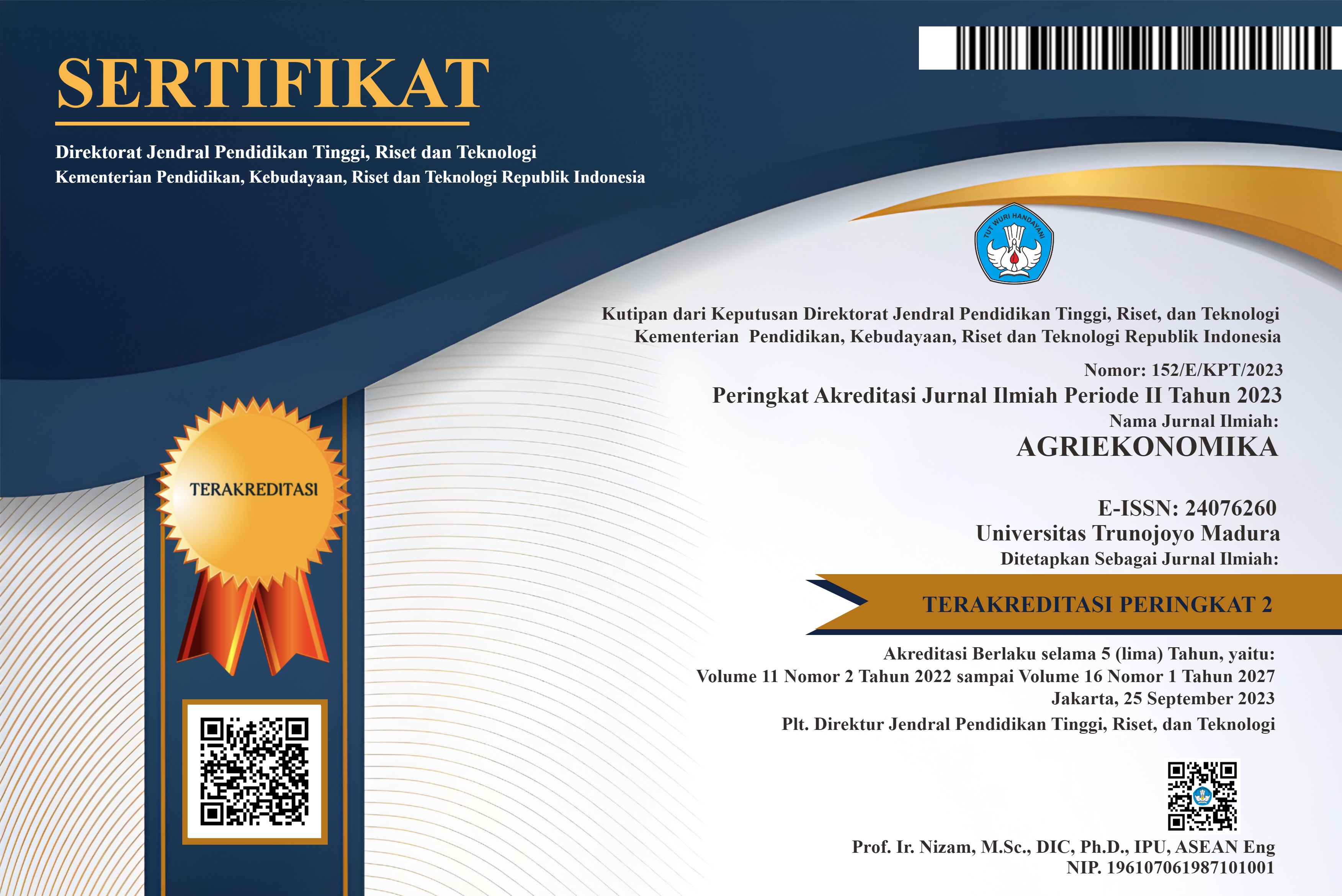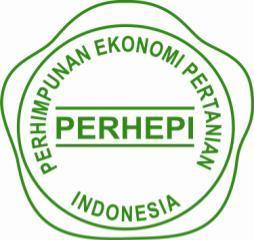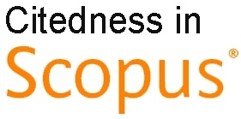INTEGRATED DESEASE MANAGEMENT FOR CHILI FARMING IN BREBES AND MAGELANG - CENTRAL JAVA: SOCIAL ECONOMIC IMPACTS
Abstract
This study aims to analyze the impact of an integrated disease management (IDM) on chilli. Chili disease control technologies that include crop barrier with corn and Crotalaria, and compost tea have been introduced to farmers in Magelang and Brebes. A qualitative approach was used to assess and estimate the socio-economic impact of agricultural research. The study was conducted in 2011. The results showed that based on land use chili, the net economic benefits generated was relatively low. There were only a few farmers who have adopted the technology on chili peppers. Furthermore, the survey also illustrates that three years after its introduction in 2007 the technology status at farm level was just at consciousness phase. Learning of this fact, a thorough evaluation of the technology on chili pepper should be done immediately. Research institutions which have developed the technology should encourage bottom-up initiatives and build a shared commitment to complete the implementation of a clear strategic plan. The adoption of the strategic plan should include the integration of research activities with promotional activities for example by revitalizing participatory approaches to awareness of farmers.
Keywords
Full Text:
PDFReferences
Alene, A.D., Manyong, V.M. Gockowski, J.. Coulibaly, O and Abele, S.. 2005. A framework for conceptualizing impact assessment and promoting impact culture in agricultural research. International Institute of Tropical Agriculture (IITA), Ibadan, Nigeria.
Ali, M., 2006. A synthesis. In Ali, M. (ed.) Chili (Capsicum spp.) Food Chain Analysis: Setting Research Priorities in Asia. Shanhua, Taiwan: AVRDC–The World Vegetable Center, Technical Bulletin No. 38, AVRDC Publication 06-678. 253pp.
Alston, J.M., Norton, G.W. and Pardey, P.G.. 1995. Science Under Scarcity. Principles and Practice for Agricultural Research Evaluation and Priority Setting. Cornell University Press and ISNAR. Ithaca.
Alwang, J. and Siegel, P.B.. 2003. Measuring the impacts of agricultural research on poverty reduction. Agricultural Economics 29:1–14.
Anderson, J.B., Desmond, A. and Green, J.R.. 2005. Determinants of farmer adoption of organic production methods in the fresh-market produce sector in California: A logistic regression analysis. Western Agricultural Economics Association Annual Meeting
Badan Litbang Pertanian, 2007. Prospek dan arah pengembang-an agribisnis komoditas bawang merah. Badan Penelitian dan Pengembangan Pertanian. Jakarta
Bank of Indonesia 2007. Lending Model Information System for Small-Scale Enterprises: Medicinal plant cultivation. 2007 The Bank of Indonesia, Jakarta
Chambers, R., Pacey, A. and Thrupp, L.A.. 1989. Farmers First: Farmer Innovation and Agricultural Research. London: Intermediate Technology Publications.
Feder, G. and Savastano, N. 2006. The role of opinion leaders in the diffusion of new knowledge: the casa of integrated pest management. World Development 34:1287-1300.
Johnson G, Weinberger K, Wu, ME. 2008. The Vegetable Industry in Tropical Asia: An overview of production and trade with a focus on Thailand, Indonesia, the Philippines, Vietnam, and India. Exploration series: No. 1, AVRDC – The World Vegetable Center, Shanhua, Taiwan.
Knepper, E.T. 2002. Factors affecting the use of fertilizer by small- and medium-sized farming households in Zambia, 1997 to 2000. A thesis submitted to the Department of Agriculture and Natural Resources, Michigan State University
Kuntariningsih, A., & Mariyono, J. 2014. Adopsi Teknologi Pertanian untuk Pembangunan Pedesaan: Sebuah Kajian Sosiologis. Agriekonomika 3(2): 180-191.
Mariyono, J. 2015. Green revolution- and wetland-linked technological change of rice agriculture in Indonesia, Management of Environmental Quality: An International Journal, 26(5): 683–700
Latifah, E., Boga, K., & Maryono, d. 2014. Pengenalan Model Kebun Sayur Sekolah Untuk Peningkatan Konsumsi Sayuran Bagi Para Siswa di Kediri - Jawa Timur. Agriekonomika 3(1): 34-44.
Mariyono, J. and Bhattarai, M. 2011. Revitalizing Indonesian rural economy through intensive farming of high value vegetables: a case of chili farming in Central Java. Indonesia’s Regional Economy in the Globalization Era. IRSA Book Series on Regional Development No. 9, 2011: 71-89.
Mariyono, J. and Sumarno, S. 2015. Chilli production and adoption of chilli-based agribusiness in Indonesia, Journal of Agribusiness in Developing and Emerging Economies, 5(1): 57–75
Morris, M.L., Tripp, R. and Dankyi, A.A.. 1999. Adoption and Impacts of Improved Maize Production Technology: A Case Study of the Ghana Grains Development Project. Economics Program Paper 99-01. Mexico, D.F.: CIMMYT
Purba, R. 2014. Produksi dan keuntungan usahatani empat varietas bawang merah di luar musim (off-season) di Kabupaten Serang, Banten. Agriekonomika 3(1): 55-64.
Rogers, E.M. 1995. Diffusion of Innovations. (5th edition). Glencoe: Free Press, USA.
Sain, G., and Martinez, J. 1999. Adoption and Use of Improved Maize by Small-Scale Farmers in Southeast Guatemala. CIMMYT Economics Paper 99-04. Mexico D.F.: CIMMYT.
Statistical Bureau, 2010 Magelang Dalam Angka. Biro Statistik Magelang.
Weinberger, K., Genova II, CA. (2005). Vegetable Production in Bangladesh: Commercialization and Rural Livelihoods. Technical Bulletin No. 33. AVRDC publication number 05-621. AVRDC – The World Vegetable Center, Shanhua, Taiwan. 36 pp.
Weinberger, K., Lumpkin, T,A. 2007. Diversification into Horticulture and Poverty Reduction: A Research Agenda. World Development 35 (8): 1464-1480.
White, B., Morey, P., Natawidjaja, R., and Morgan, W., 2007. Vegetable value chains in Eastern Indonesia–a focus on chilli. SADI-ACIAR Research Report, Indonesia Australia Partnership.
DOI: https://doi.org/10.21107/agriekonomika.v5i2.1686
Refbacks
- There are currently no refbacks.







